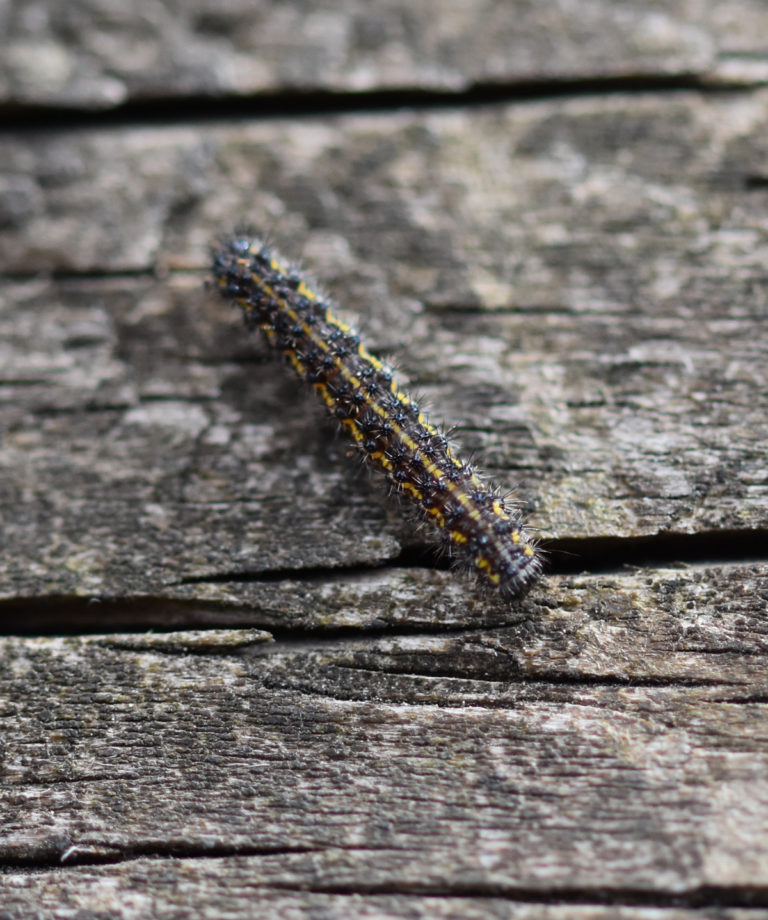
No caterpillar has a more bizarre life than this. The male emperor is renowned for being able to locate a female by scent, even over long distances. The caterpillars can be found from May to August, eventually spinning a large cocoon from which the moth will emerge the next spring. The favoured food plant is heather, but brambles, blackthorn and hawthorn are also devoured. Its spiracles (external openings that allow oxygen into the body) are bright orange, rimmed with black. So, too, is the mature caterpillar, with its dark or yellowish-green body with transverse bands of black. The emperor is everybody’s favourite moth: it’s big and beautiful. The first caterpillars are usually seen in May, but most emerge in June, when many are quickly gobbled up by parasitic wasps. Once they’re on the loose, the spines on their bodies help to protect them from predators and the caterpillars, which jerk their heads, move their bodies in unison. New webs are spun once the leaves have been eaten until, eventually, the large black caterpillars emerge to live in the open. Some of the first generation will be golden adults that will breed that summer others will be dark specimens that will hibernate, emerging the following spring.įemale peacocks lay their eggs in sticky piles on large and vigorous stinging nettles, over the tips of which, after hatching, the caterpillars spin a communal web. There are two generations a year, so caterpillars can be found (usually on nettles) in May/June and again in September. When fully mature, it’s tan, with a bright splash of white. After each shedding of the skin, the caterpillar looks increasingly like a bird dropping. Just as the adult comma is a master of camouflage, resembling, when at rest, a tattered leaf, so its caterpillar is equally adept at disguise. However, a parasitic wasp called Cotesia glomerata lays its eggs in the caterpillars, eventually killing up to 80% of the population. They may look vulnerable to hungry birds, but their bodies accumulate poisonous oils of mustard gas that deter most predators.

They feed in unison, being stimulated to eat by the oily fumes from the damaged leaves. At first, the young caterpillars concentrate on the outer leaves, nipping holes between the veins, until, eventually, only a skeleton remains. Second only to the slug as the gardener’s enemy, the caterpillars of the large white butterfly are specialist eaters of brassicas. Large or cabbage white butterfly caterpillar When alarmed, the caterpillar flicks out a pair of orange scent glands from behind the head, emitting a strong smell, but that’s not sufficient to deter reed buntings and sedge warblers, both of which are major predators. It’s a handsome creature, with a green body with transverse black bands, the latter spotted with red. Until their third moult, the caterpillars resemble small bird droppings, so are difficult to find, but the mature caterpillar is much easier to spot. To see the caterpillars of the swallowtail, you have to go to the Norfolk Broads in mid summer and search the leaves of milk parsley. Although these caterpillars hatch in July, they go into hibernation when they’re still quite small and complete their growth the following spring. Most gardeners know it as the woolly bear and, as it’s not fussy, it can be found feeding on almost any low-growing plant. It sports dense tufts of hairs that grow from small raised warts and has a shining black head. Its handsome, hairy caterpillar is equally distinctive, if less colourful. With its dramatic warning colours-black-and-white forewings and scarlet rear wings-the garden tiger is one of the most familiar and easily identifiable moths.

They’re not to be touched, however, as their hairs are highly irritating and can cause a painful rash. Once the weather warms up, the caterpillars emerge, moving in processions, head to tail. The obvious signs of this moth’s presence are the conspicuous communal nests in which the caterpillars remain all winter.

It will be an unwelcome immigrant, for this Mediterranean species is a major pest, its caterpillars able to strip a pine tree of its needles. Not yet established in the UK, this is a moth that is moving steadily north through Europe and may well start breeding here. Some caterpillars pupate within weeks of hatching and others overwinter, but, frustratingly, few are as easy to identify as that of the elephant hawk-moth. The caterpillar is the growing stage in the insect’s life and it will moult several times to enable its body to expand.The stage between each moult is called an instar and most species undergo this process four to six times. Country Life's Top 100 architects, builders, designers and gardenersĬaterpillars are part of the four-stage lifecycle of every butterfly and moth: egg, caterpillar, pupa and adult.


 0 kommentar(er)
0 kommentar(er)
